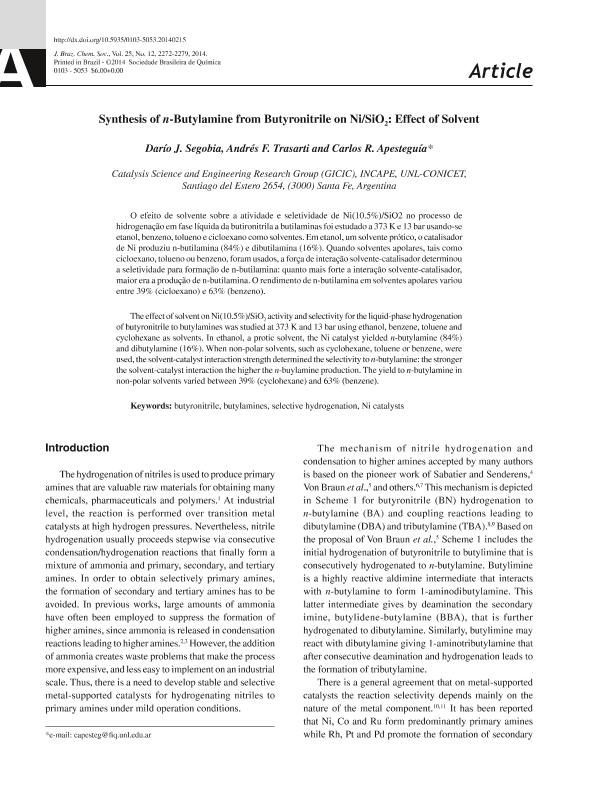Artículo
The effect of solvent on Ni(10.5%)/SiO2 activity and selectivity for the liquid-phase conversion of butyronitrile to butylamines was studied using ethanol, benzene, toluene and cyclohexane as solvents. In ethanol, a protic solvent, the Ni catalyst yielded n-butylamine (84%) and dibutylamine. Replacing ethanol by non-polar solvents (benzene, toluene, cyclohexane) caused significant changes in catalyst activity and selectivity. In particular, the selectivity to n-butylamine decreased at the expense of dibutylamine and tributylamine formation. The solvent effect on the catalyst performance was interpreted by considering: i) the solvent-catalyst interaction strength that was investigated by calorimetry, and temperature-programmed desorption of solvents characterized by mass spectrometry; ii) the solvent polarity and its ability for H-bond formation with n-butylamine. O efeito de solvente sobre a atividade e seletividade de Ni(10.5%)/SiO2 no processo de hidrogenação em fase líquida da butironitrila a butilaminas foi estudado a 373 K e 13 bar usando-se etanol, benzeno, tolueno e cicloexano como solventes. Em etanol, um solvente prótico, o catalisador de Ni produziu n-butilamina (84%) e dibutilamina (16%). Quando solventes apolares, tais como cicloexano, tolueno ou benzeno, foram usados, a força de interação solvente-catalisador determinou a seletividade para formação de n-butilamina: quanto mais forte a interação solvente-catalisador, maior era a produção de n-butilamina. O rendimento de n-butilamina em solventes apolares variou entre 39% (cicloexano) e 63% (benzeno).
Synthesis of n-Butylamine from Butyronitrile on Ni/SiO2: Effect of Solvent
Fecha de publicación:
06/2014
Editorial:
Sociedade Brasileira de Química
Revista:
Journal of the Brazilian Chemical Society
ISSN:
0103-5053
e-ISSN:
1678-4790
Idioma:
Inglés
Tipo de recurso:
Artículo publicado
Clasificación temática:
Resumen
Palabras clave:
Butyronitrile
,
Butylamines
,
Selective Hydrogenation
,
Ni Catalysts
Archivos asociados
Licencia
Identificadores
Colecciones
Articulos(INCAPE)
Articulos de INST.DE INVEST.EN CATALISIS Y PETROQUIMICA "ING. JOSE MIGUEL PARERA"
Articulos de INST.DE INVEST.EN CATALISIS Y PETROQUIMICA "ING. JOSE MIGUEL PARERA"
Citación
Apesteguia, Carlos Rodolfo; Trasarti, Andres Fernando; Segobia, Dario Jobino; Synthesis of n-Butylamine from Butyronitrile on Ni/SiO2: Effect of Solvent; Sociedade Brasileira de Química; Journal of the Brazilian Chemical Society; 25; 12; 6-2014; 2272-2279
Compartir
Altmétricas




